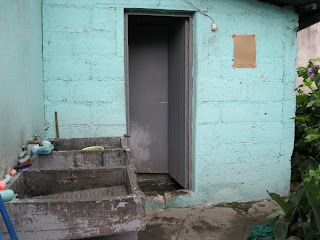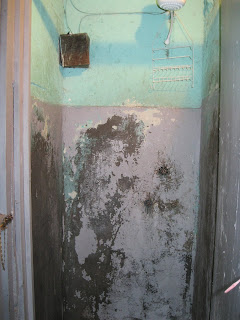One of the best parts of the stove project is that it takes you to places that you would never visit otherwise. This location is near Llanos del Pinal, kind of. The picture below is trying to show the worst road I have ever seen, but it does not do it justice. We had to get out of the van that we were in because it got stuck. Not in mud or anything, just because water had put such huge ruts in the road that basically only pick-ups could pass and even then top speed is probably 5 mph. It was crazy.

So then we unload the trees and are carrying them to the site because the van could not get us there. We ended up putting them down by the river and we thought we would plant there and it would be fun and sunny and nice by the river.

However, when we asked where we needed to plant Carmencita pointed to this hill... across the river. And we kept asking her to clarify thinking that we had misheard or misunderstood the Spanish because there was no bridge or log or anything near by, but we had met up with some of the local villagers and this guy put a crate of trees on his shoulder and just walked across the river. It wasn't hard for him because the river was only about a foot deep at maximum, but he was wearing huge rainboots. The other students and I asked, "okay that's great that he can just walk, but how are we supposed to get across?". The answer was remove your socks and shoes, put them in the crate with the trees and carry it across.

You can see the in the far side of the picture the local man carrying the trees on his shoulder. He just took a box from one of the other students as Melanie waded in with her box of trees, which is pretty heavy.

We ended up forming a line and passing the crates of trees along. Melanie is smiling in the picture because she can still feel her toes. 5 crates of trees later we were all freezing because it gets really cold in the hills at night and the water was frigid. Luckily there were only 8 crates total. We found a bunch of "rocks", really pieces of cement blocks, on the other side of the river that we put in water to form a little path across for the way back.

After we got across we had to put our socks and shoes on over our wet, cold feet and we still had to carry 125 trees up the mountain and plant them. It was pretty chilly, but I was dripping with sweat because those tree crates are heavy and you have to spread them out so you end up carrying the huge crate all over the mountain (okay it was a hill, but it felt like a mountain).
Here is a picture of Melanie lovingly planting a little tree in the ground (I promise there is a tree behind that tall grass). I don't have a lot of pictures because my hands (and whole body) were covered with dirt and sweat all day.

At the end of the day a local woman who organizes the project in the local community fed us snacks of watermelon chunks and horchata which is a sweet drink made from arroz (rice). The watermelon was refreshing, but the horchata was served a little warm so it wasn't quite as refreshing as we were hoping, but it was good to talk to her about the history of the tree project. The other people we worked with did not speak Spanish so we really could not communicate well. There are many languages spoken throughout Guatemala and many of them sound similar so it is really hard for us to know what people are saying. I think these people spoke Kachiquel.

At the end of the day a local woman who organizes the project in the local community fed us snacks of watermelon chunks and horchata which is a sweet drink made from arroz (rice). The watermelon was refreshing, but the horchata was served a little warm so it wasn't quite as refreshing as we were hoping, but it was good to talk to her about the history of the tree project. The other people we worked with did not speak Spanish so we really could not communicate well. There are many languages spoken throughout Guatemala and many of them sound similar so it is really hard for us to know what people are saying. I think these people spoke Kachiquel.




























